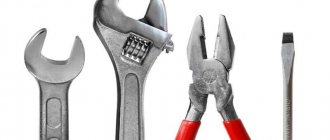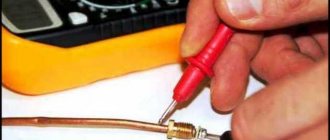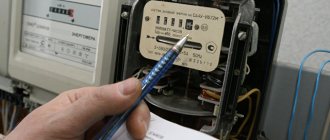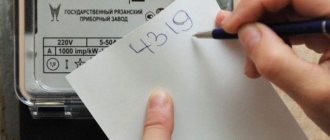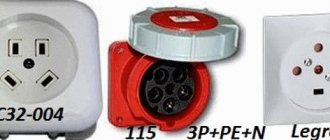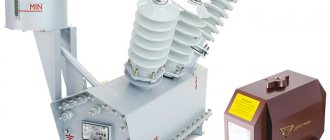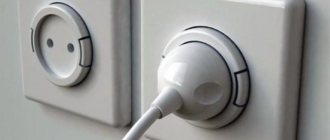Checking electric meters. Timing for verification of the electric meter. Frequency of verification of electric meters. Cost of checking electric meters. The electric meter verification period has expired
Individuals may not have their meters verified until January 1, 2022
Verification of electricity metersIf you purposefully came to the page of the website of the Federal Budgetary Institution "Rostest-Moscow" "Verification of electric meters", then you most likely know that the electric meters installed in our homes require periodic verification, that is, official and competent confirmation of their suitability for further use in as a metering device. |
Checking electricity meters
The obligation to install metering devices in residential and non-residential premises of apartment buildings is established by Federal Law No. 261-FZ of November 23, 2009. Apartments must be equipped with individual metering devices; in addition, the owners of the premises are required to equip each apartment building with communal metering devices.
Just installing meters is not enough, they need to be maintained. Today you will learn about how the meter is verified - a mandatory event during which it is necessary to confirm the suitability of the meter - and how to replace the meter if its service life has expired or it has not passed the test.
In accordance with clause 31 of the Decree of the Government of the Russian Federation dated 05/06/2011 No. 354, the provider of utility services is obliged to monitor:
- availability of metering devices;
- the state of the meters;
- the reliability of the PU readings provided.
The condition of common house metering devices must be checked at least once a year. Individual metering devices located in the consumer’s residential premises can be checked no more than once every 3 months.
RF PP 1498: how to check metering devices
453880
How does the shelf life differ from the inter-verification period and the warranty period?
The moment any electric meter is checked and sealed, its service life begins. This is not the same period of 25 years indicated in the manufacturer’s passport (25 years is the approximate period, the shelf life during which the device will remain in working condition, according to the factory’s calculations).
In the documentation, next to the commissioning date, the time and date of the next test that will need to be performed is indicated. Otherwise, this period is called the inter-verification interval (MPI).
The fact is that although the device as a whole continues to work, from time to time malfunctions invisible to the eye may appear in it, and the error may increase, which must be identified and eliminated.
The warranty period for electric meters, as for any other device, is the period during which the buyer can count on free warranty service, repair or replacement.
Different manufacturers indicate different warranty periods, for example 5 years.
Calibration intervals may differ for different meter models. For single-phase – 2 years. For three-phase - a year. Electronic meters can be checked less frequently: once every 4 to 16 years.
In addition, different types of inspections may be scheduled for different interverification periods. So, if an electric meter is subjected to metrological control once every 16 years, then it will be checked for serviceability of the internal battery and errors in operation every 6 years. Checking the reliability of circuit connections can be ordered by energy sales organizations in accordance with their work schedules.
The essence of such a check (connection reliability) is to remove the cover, remove dust from the contacts, tighten the bolts and reseal the seal.
The start of the verification interval is the date of sealing and commissioning, and not the date of production or purchase.
After the verification interval has expired, the metrological service can conclude that the meter is still in good condition and can continue to be used.
Shelf life and service life: what's the difference?
Each metering device has its own technical passport, which contains a mark from the factory laboratory about the tests carried out on the product and its approval for operation. Therefore, many people have a question about the need for additional checks given the expiration date of 20-25 years indicated in the passport.
The fact is that this shelf life should be distinguished from the guaranteed service life. After its release, the meter can lie in packaging for 5, 10, 15 or even 20 years, but it will still be considered suitable for installation if the established deadlines have not been violated.
Therefore, when assigning control checks, the reference point is the service life of the electric meter, which is associated with the intensity of work processes. After all, the conditions of use vary.
One meter can be installed in a country house or in an empty apartment where electricity is rarely used, occasionally. The other, on the contrary, is in constant work and is subject to intense wear and tear.
Induction devices, the main parts of which are in constant rotation, are especially affected.
After a certain period of time, the device will produce data with large errors, which will gradually continue to increase. For timely detection and elimination of the consequences of wear, an inter-verification time interval is assigned.
Without this proof test, the instrument manufacturer does not guarantee its accurate operation after a specified period of time.
The timing of such checks and complete replacement of electricity meters largely depends on the specific model and design features of a particular device.
Calibration intervals and replacement periods
Each electric meter model has its own calibration interval, noted in its technical data sheet. It begins to be calculated from the moment the device is put into operation, and not from the time of purchase or date of manufacture.
Each meter is equipped with a seal indicating the expiration date. For single-phase devices it is 2 years, and for three-phase devices it is 1 year.
If during this period of time the device has not begun to be used, then without performing a new verification it cannot be used for accounting.
In all apartments and private houses, representatives of the service organization inspect the meters every six months, and in other facilities - every year.
However, sooner or later the time comes when, during the next inspection, it turns out that the electric meter is no longer capable of performing its functions. Many people begin to remember the service life of the meter and quickly decide when to change the electric meter.
As a rule, the total period of operation of the device by this time is 16 years. In addition, the reason for replacement may be an unexpected failure of the device, which is detected by the subscriber himself.
The device is dismantled and sent to the metrology service for examination for possible further use.
Currently, widespread replacement and installation of new equipment is being carried out, even if the current meter has not been completed by the established inspection date. This measure was initiated by a special government resolution, which requires the installation of metering devices with an accuracy class of at least 2.0.
In addition, all electricity meters with obvious mechanical damage, broken glass, or a faulty counting mechanism must be replaced.
Meters that have been declared invalid by the regulatory authority are being replaced due to discrepancies between the readings of the actual electricity consumed.
A new device is installed instead of the old one and in case of the user’s personal desire to switch to a multi-tariff mode.
After removing the old meter, a special tariff will be used for electricity calculations for this period. The maximum period from the installation of a new device to its sealing is set at one month.
Types of electricity control control checks
There are two types of meter checks: primary and periodic. The metering device undergoes initial verification at the manufacturer before installation and use for its intended purpose.
Periodic inspection is carried out until the end of the prescribed revision interval. An extraordinary check of the electricity meter may also be scheduled. It is carried out if:
- there is no document confirming the periodic inspection;
- there is a confirmed need to configure such a counter;
- There was a need to install a new meter.
Inspection intervals may vary for different types of instruments. Also, the frequency of the audit may be affected by various emergency situations.
Electricity metering can only be carried out using a meter that has a product passport or a certificate confirming its compliance with current standards.
Carrying out inspections of metering devices is the responsibility of special organizations. You can call a specialist from such an organization to your home. If this option does not seem reliable enough to you, take the meter to a special organization. After checking the measuring device, you will be given an inspection report.
What the RA needs to know about the installation of common house metering devices
178774
Electronic meters
However, the most effective equipment for monitoring energy consumption is electronic meters. The operating principle of the devices is based on direct measurement with subsequent data processing and transmission to the indicator and to the device’s memory. In addition, electronic meters are characterized by the following:
- high accuracy class;
- possibility of collecting data from a distance;
- accounting at several tariffs.
The service life of the electricity meter in the apartment is indicated in its technical documentation and is about 32 years. This allows you to recoup the rather high cost of the device and use it in the future, saving on payments by sharing tariffs. Despite the initial accuracy of measurements, under the influence of certain factors the indicators can be significantly distorted. To confirm serviceability, devices should be checked regularly. The period of time between these events is also recorded in the accompanying documents.
An electric meter is a device for measuring the waste of electrical energy of direct or alternating current. The first electricity measuring instruments for power supply arose and began to be used in the late 80s of the 19th century. Then they were bulky and very inconvenient to use, but in the modern world a number of all kinds of electricity meters with all sorts of functions have appeared (electromechanical, electrolytic, electronic, programmable and even with liquid crystal indicators). For both old and new meter models, the question still remains: what is the service life of the electric meter and how often do they need to be changed?
There are two main types of electricity meters on the market today. They are divided by type of action into:
- induction;
- electronic.
Let's take a closer look at the pros and cons of each type. Which meters are more reliable? Where will the service life of the electric meter be longer? The design of the device determines its durability and accuracy.
Induction electricity meters operate using magnetic wires and a reporting device, which are driven by the current flowing between them. It is noteworthy for induction meters that they are not protected from theft and have a limited number of features and functions; in addition, their accuracy class and energy consumption are poor.
In turn, electronic meters, as high-precision devices, are equipped with a shunt and perform the task of a current sensor. The device is also equipped with a board chip, which is designed to collect data (electrical device readings) and display a report on the screen. A characteristic feature of these meters is also considered to be the ability to record several tariffs, and the high level of accuracy and safety of consumption indicators indicates the functionality of this device. Conclusion: The previously reliable and inexpensive induction meters used in the last century are being replaced by electronic ones with a high level of accuracy and innovation.
Today, housing and communal services routinely replace old electricity meters in homes and determine the service life of the electricity meter. The reason is modern technology, energy-intensive household appliances, air conditioners, stoves, washing machines, etc., which overload all old meters and lead to fire and various emergency situations.
Hybrid meters are a rare device for measuring used electricity and have a digital interface. Endowed with qualities of both induction and electronic type and mechanical computing capabilities.
Stages of checking electricity meters at home
The first thing people pay attention to when checking an electricity meter is that it is connected correctly. Using a visual inspection, the meter is checked for the absence of additional connections and connection failures.
Unaccounted for electricity consumption may be indicated by:
- the presence of holes in the meter that are not provided by the manufacturer;
- violations in the fastening of the glass of the metering device;
- presence of an unintended connection;
- presence of a loose connection screw.
Any of these signs indicates that the rules for using the meter are being violated and electricity is being used illegally.
At the next stage, the inspector calculates the self-propelled vehicle. The term “self-propelled” is used to refer to situations in which the disk of the metering device rotates without load.
Then the gear ratio of the metering device is checked. The gear ratio refers to the number of times the disk rotates or the electronic indicator blinks when one kilowatt of energy is consumed.
The next stage is to identify the measurement error of the metering device. It is carried out in one of three ways:
- current clamps;
- multimer;
- electrical appliance.
If checking the meter reveals a measurement error of more than 10%, the device will have to be replaced.
The last thing you need to do when checking the drive is to determine its magnetization, since under certain conditions the magnetic field can not only slow down, but also accelerate the disk, which will increase the size of the bills for consumed electricity.
On the issue of installing metering devices in apartment buildings
147700
Reasons for failure before the end of the official service life
No water meter can work forever. Flow meters often break down before the end of the official operating period. Most inexpensive meters have to be replaced when the next verification is due. That is, after 4 years for hot water, 6 years for cold water.
The malfunction is recognized simply: the water meter stops correctly determining the volume or stops completely. In this case, the official deadlines for replacing water meters are no longer relevant. Devices will have to be repaired or replaced immediately.
Possible malfunctions:
- depressurization;
- incorrect installation;
- clogged pipeline;
- high pressure;
- illegal interference with the operation of the counting mechanism;
- heat.
Depressurization is an easily recognizable type of failure of a measuring device. It starts with slight fogging of the front glass and ends with streams of liquid gushing from the water meter in different directions. Most often, depressurization of the housing occurs when it is deformed from loads arising in the pipeline, or when it is distorted during installation.
Just as often, the flow meter gives incorrect readings due to incorrect installation. Important components may be loose or poorly tightened, or the hot and cold water inlets may be mixed up.
High hardness and increased salt content in the flowing liquid contribute to the formation of sludge build-up both in the pipeline and on the walls of the water meter itself. Vodokanal cannot always provide satisfactory water quality in water supply systems. Many indicators are within the limit values, and some may exceed them, which significantly reduces the service life. If the water is of poor quality, you need a coarse filter in front of the water meter.
High pressure in the water supply system is one of the possible causes of depressurization; it affects the housing and impeller.
Some residents who want to save money on housing and communal services interfere with the operation of the counting mechanism using illegal means. Magnets, pins, etc. are used to stop or slow down the water meter. External influence on the counting mechanism leads to its breakdown or leaves noticeable marks. Any interference is punishable by a fine and the purchase of a new device.
High temperatures (more than 90°C) lead to deformation of the plastic parts of the water meter, followed by their replacement or the purchase of a new water meter.
These circumstances determine how often water meters need to be replaced.
Laboratory testing of PU
Checking metering devices in the laboratory consists of several stages:
1. External inspection.
External inspection allows you to identify mechanical deformations of the meter body or elements. At this stage, the presence of a personal PU number, its configuration or labeling is checked. All elements must comply with current state standards.
2. Checking the insulating elements.
Such a check may not be carried out in relation to new meters, as well as those PUs that have been serviced by a specialized organization where the strength of the insulating elements was tested. Also, verification can be avoided if it is established that the seal is intact, confirming the integrity of the insulation.
3. Testing and checking the correct functioning of the counting mechanism.
At this stage, the device is connected to the mains and warmed up for a quarter of an hour. The power transmission mode and voltage must be within the minimum values. The counter can be monitored by measuring the frequency indicator of disk rotation.
4. Confirmation of the absence of a self-propelled vehicle.
For such a test, electricity is transmitted through a parallel circuit with a voltage of 115% of the rated voltage. The procedure takes place in the absence of voltage in the series connection at the rated voltage of the power source and auxiliary electrical circuits. The duration of the study is 600 seconds. Such a check is not carried out in relation to devices whose design features exclude the possibility of self-propulsion.
5. Checking the sensitivity threshold.
For 600 seconds against the background of the rated voltage of the electrical circuit parallel to the meter and the source of electricity.
At the same time, the relative and basic error of the meter is monitored to ensure compliance with the values provided by the developers. To establish the error, voltage and current meters and a stopwatch are used.
If the study shows that the meter does not meet any parameters, it must be replaced.
When does an individual metering device begin to operate?
150232
What is the service life of an electric meter?
Electricity meters come in two types, using different measurement principles and, accordingly, different designs.
Induction or mechanical
The design is based on the principle of electromagnetic induction. The current consumed passes through the coil, which creates a magnetic field. This field rotates a disk, which is connected by a worm gear to the gears of the dial. The more current passes, the greater the magnetic field and the faster the disk rotates.
Single-phase induction meter SO-I446M
The service life of induction meters is considerable, about 30 years.
Electronic
Modern electronic metering devices are distinguished not only by high accuracy, but also by the absence of moving mechanisms, which theoretically increases their service life. “Theoretically”, since devices have recently entered our lives, and they have not yet had time to be tested by time.
The instructions for electronic meters indicate a shelf life of 25 years - 30 years.
Electronic counter
Hybrid
The concept of a “hybrid” meter, in fact, does not exist. The design of the device is either mechanical or electronic. Models that have external features of both are sometimes called hybrid.
The model may have a mechanical filling, but at the same time be compact, with an attractive interface and LCD display.
On the other hand, many electronic devices are equipped with a simpler and more familiar mechanical dial with scrolling numbers on the rollers.
This mixed option usually costs slightly less and helps save on the purchase of a device while maintaining high precision electronic design.
Remote meters are used in private homes. The box for the street electricity meter ensures safe operation of the device.
The transformation ratio of an electricity meter is a value indicating the accuracy of the device. You will learn how to calculate this value in this material.
Mixed type
Hybrid meters mainly include models whose design contains parts of the two devices described above. Mixed counters do not exist as a separate class. Inside they can be either induction or electronic. For example, a device in which there is a magnetic coil and a screen is located outside is considered mixed.
Calibration interval table
For hybrid electrical appliances, the service life is set depending on the design - 25-30 years. These models are much cheaper than induction and electronic ones.
Mandatory replacement of electrical devices
In some cases, using loopholes will not work. The law establishes a clear list of devices that are subject to mandatory replacement. First of all, these include the following situations:
- planned replacement of electrical metering devices, which is carried out in connection with updating network requirements or due to other work;
- breakdown, occurrence of malfunctions, failures, incorrect display of indicators;
- replacement is necessary due to the expiration of the electric meter (the specific period is indicated in the technical documents).
The law does not establish requirements for choosing the type of electric meter. You can install and register any type - induction, electronic, hybrid.

